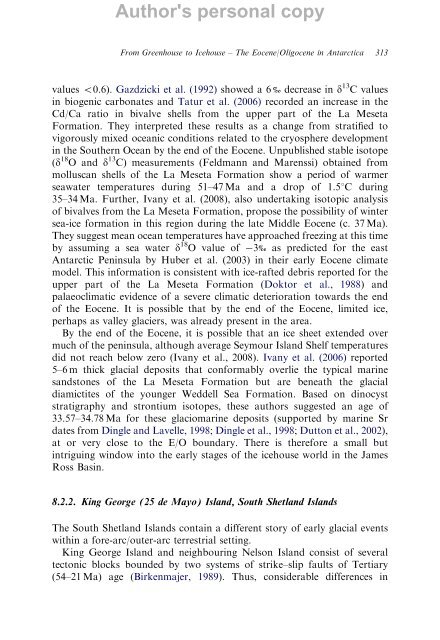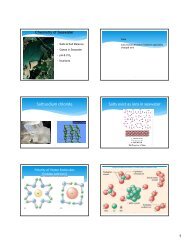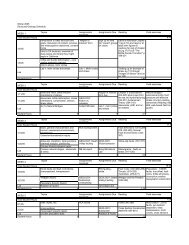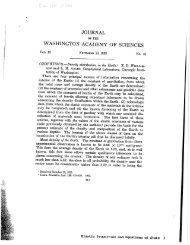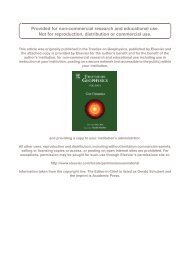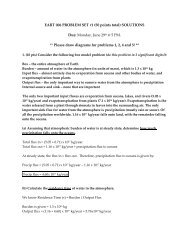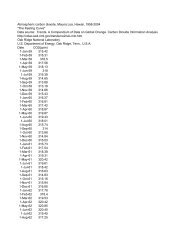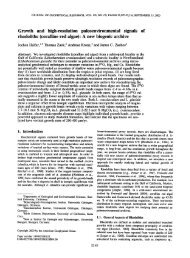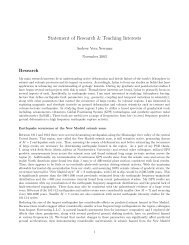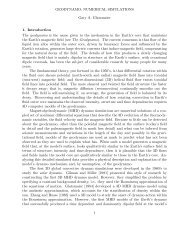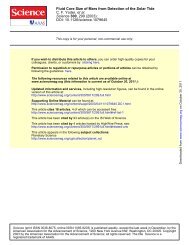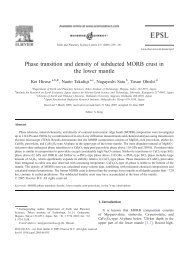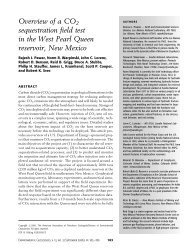From Greenhouse to Icehouse – The Eocene/Oligocene - UMass ...
From Greenhouse to Icehouse – The Eocene/Oligocene - UMass ...
From Greenhouse to Icehouse – The Eocene/Oligocene - UMass ...
Create successful ePaper yourself
Turn your PDF publications into a flip-book with our unique Google optimized e-Paper software.
Author's personal copy<br />
<strong>From</strong> <strong>Greenhouse</strong> <strong>to</strong> <strong>Icehouse</strong> <strong>–</strong> <strong>The</strong> <strong>Eocene</strong>/<strong>Oligocene</strong> in Antarctica 313<br />
values o0.6). Gazdzicki et al. (1992) showed a 6 m decrease in d 13 C values<br />
in biogenic carbonates and Tatur et al. (2006) recorded an increase in the<br />
Cd/Ca ratio in bivalve shells from the upper part of the La Meseta<br />
Formation. <strong>The</strong>y interpreted these results as a change from stratified <strong>to</strong><br />
vigorously mixed oceanic conditions related <strong>to</strong> the cryosphere development<br />
in the Southern Ocean by the end of the <strong>Eocene</strong>. Unpublished stable iso<strong>to</strong>pe<br />
(d 18 O and d 13 C) measurements (Feldmann and Marenssi) obtained from<br />
molluscan shells of the La Meseta Formation show a period of warmer<br />
seawater temperatures during 51<strong>–</strong>47 Ma and a drop of 1.51C during<br />
35<strong>–</strong>34 Ma. Further, Ivany et al. (2008), also undertaking iso<strong>to</strong>pic analysis<br />
of bivalves from the La Meseta Formation, propose the possibility of winter<br />
sea-ice formation in this region during the late Middle <strong>Eocene</strong> (c. 37 Ma).<br />
<strong>The</strong>y suggest mean ocean temperatures have approached freezing at this time<br />
by assuming a sea water d 18 O value of 3m as predicted for the east<br />
Antarctic Peninsula by Huber et al. (2003) in their early <strong>Eocene</strong> climate<br />
model. This information is consistent with ice-rafted debris reported for the<br />
upper part of the La Meseta Formation (Dok<strong>to</strong>r et al., 1988) and<br />
palaeoclimatic evidence of a severe climatic deterioration <strong>to</strong>wards the end<br />
of the <strong>Eocene</strong>. It is possible that by the end of the <strong>Eocene</strong>, limited ice,<br />
perhaps as valley glaciers, was already present in the area.<br />
By the end of the <strong>Eocene</strong>, it is possible that an ice sheet extended over<br />
much of the peninsula, although average Seymour Island Shelf temperatures<br />
did not reach below zero (Ivany et al., 2008). Ivany et al. (2006) reported<br />
5<strong>–</strong>6 m thick glacial deposits that conformably overlie the typical marine<br />
sands<strong>to</strong>nes of the La Meseta Formation but are beneath the glacial<br />
diamictites of the younger Weddell Sea Formation. Based on dinocyst<br />
stratigraphy and strontium iso<strong>to</strong>pes, these authors suggested an age of<br />
33.57<strong>–</strong>34.78 Ma for these glaciomarine deposits (supported by marine Sr<br />
dates from Dingle and Lavelle, 1998; Dingle et al., 1998; Dut<strong>to</strong>n et al., 2002),<br />
at or very close <strong>to</strong> the E/O boundary. <strong>The</strong>re is therefore a small but<br />
intriguing window in<strong>to</strong> the early stages of the icehouse world in the James<br />
Ross Basin.<br />
8.2.2. King George (25 de Mayo) Island, South Shetland Islands<br />
<strong>The</strong> South Shetland Islands contain a different s<strong>to</strong>ry of early glacial events<br />
within a fore-arc/outer-arc terrestrial setting.<br />
King George Island and neighbouring Nelson Island consist of several<br />
tec<strong>to</strong>nic blocks bounded by two systems of strike<strong>–</strong>slip faults of Tertiary<br />
(54<strong>–</strong>21 Ma) age (Birkenmajer, 1989). Thus, considerable differences in


